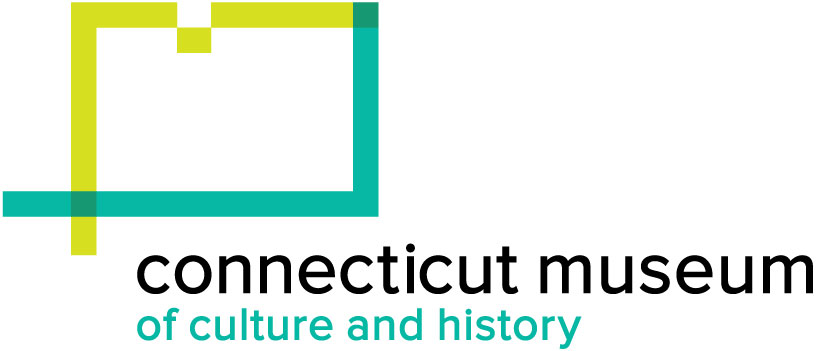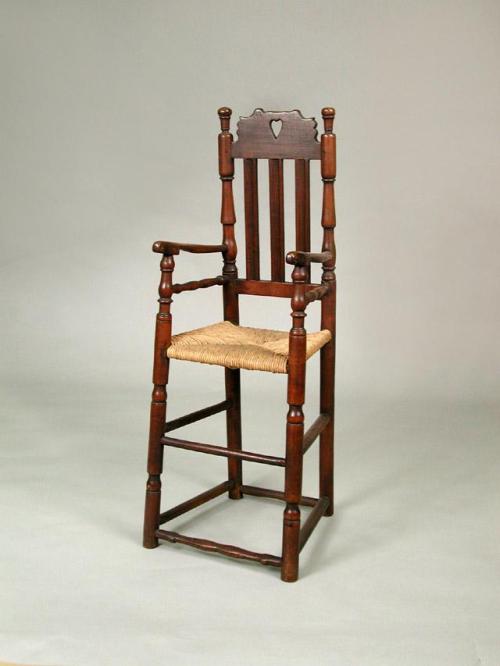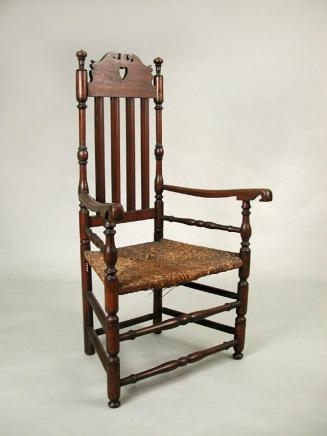Highchair
Furniture MakerAttributed to
James Davidson II
(American, 1737 - 1826)
Dateabout 1762
MediumMaple, ash, rush
DimensionsPrimary Dimensions (overall height x width x depth): 38 1/8 x 14 3/4 x 14in. (96.8 x 37.5 x 35.6cm)
ClassificationsFurniture
Credit LineBequest of George Dudley Seymour
Object number1945.1.1148
DescriptionMaple highchair in the William and Mary, or early baroque, style, with a heart and crown style crest rail, a banister-back, turned rails, front legs, and stretchers, and a rush seat. The back of the highchair is formed by a pierced crest rail with a shaped upper edge, at the top between two turned stiles. Each stile has a ball-and-urn-shaped finial at the top. The crest rail has a wide, tall center section with a raised tulip in the center (now missing) over a pierced heart; to each side of this is a small spur (now broken), and a recessed quarter circle, over an undulating edge that drops down to a small fillet, or horizontal. Below the crest rail are three banisters, each with a recessed, molded front; each banister attaches at the bottom to the stay rail. Above the seat, each stile is turned with cone, baluster, and ring forms. Below the seat, each stile forms a cylindrical back leg. The underside of each arm is bowed down in the center; each arm has a tightly curled handhold that extends well past the top of the front leg. Each front leg is turned with a baluster over three cylinders, each separated by an ovoid turning. Above the seat, each front leg supports the arm. The highchair has a trapezoidal rush seat. Each side of the highchair has a double-baluster turned stretcher below the arm and above the rush seat, connecting the upper portion of the front leg to the stile at the back. The front of the highchair has two turned stretchers; the top stretcher is plain (replaced), and the bottom stretcher is turned with a double-baluster form. Each side has two plain turned stretchers. The back has one plain turned stretcher at the foot.
Condition: Portions of the shaped top of the crest rail have broken off. The top front stretcher is replaced, and the lower front stretcher is well worn. The left stile, above where the arm meets it, has broken and has been repaired. Wood has broken off of the left side of each stile, at and below the height of the back seat rail. The highchair has lost height at the bottom of each leg. The frame is refinished, and the rush is replaced.
Design and Construction Details: The crest rail has a rectangular tenon at each side that extends into the cylinder near the top of each stile; each of these joints is secured with a wooden pin. Each banister is tenoned into the crest rail above and into the stay rail below. The stay rail has a rectangular tenon at each end that extends into the stile. The back of each arm is tenoned into the stile. The underside of the handhold is curled. Behind where the leg joins the arm, there is a sharp notch in the underside of the arm. Each front leg is tenoned into the arm above; each of these joints is secured with a wooden pin. Each seat rail is probably bladelike, with a rounded outer edge and a tapered inner edge. The seat rails and stretchers have round tenons that extend into the front or back legs. Incised lines circle the stiles and front legs, marking the placement of the seat rails and stretchers.
Condition: Portions of the shaped top of the crest rail have broken off. The top front stretcher is replaced, and the lower front stretcher is well worn. The left stile, above where the arm meets it, has broken and has been repaired. Wood has broken off of the left side of each stile, at and below the height of the back seat rail. The highchair has lost height at the bottom of each leg. The frame is refinished, and the rush is replaced.
Design and Construction Details: The crest rail has a rectangular tenon at each side that extends into the cylinder near the top of each stile; each of these joints is secured with a wooden pin. Each banister is tenoned into the crest rail above and into the stay rail below. The stay rail has a rectangular tenon at each end that extends into the stile. The back of each arm is tenoned into the stile. The underside of the handhold is curled. Behind where the leg joins the arm, there is a sharp notch in the underside of the arm. Each front leg is tenoned into the arm above; each of these joints is secured with a wooden pin. Each seat rail is probably bladelike, with a rounded outer edge and a tapered inner edge. The seat rails and stretchers have round tenons that extend into the front or back legs. Incised lines circle the stiles and front legs, marking the placement of the seat rails and stretchers.
Status
Not on view












